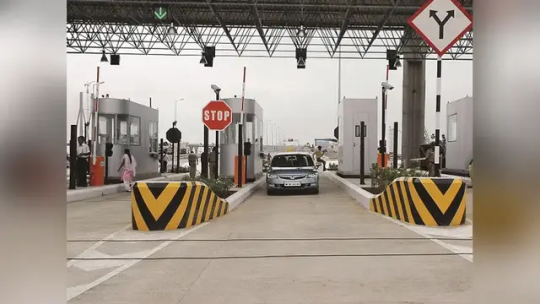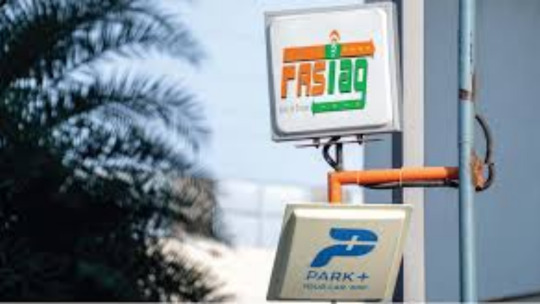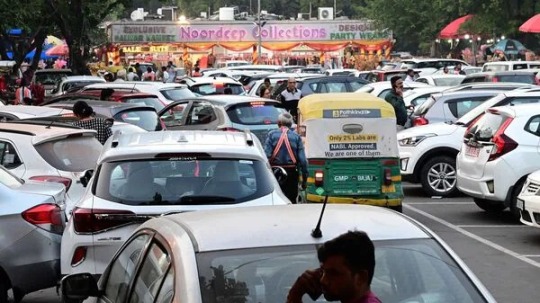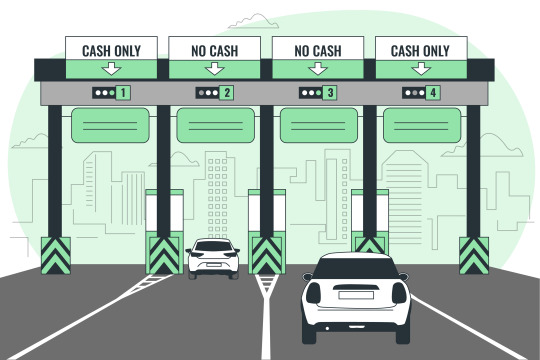#Fastag
Explore tagged Tumblr posts
Text

No Toll for Two-Wheelers! NHAI Clears the Air 🛵✨
The National Highways Authority of India (NHAI) has officially dismissed viral rumors about imposing toll tax on two-wheelers. Contrary to misleading claims, no toll charges will be levied on motorcycles or scooters traveling on national highways.
🔹 Two-wheelers remain toll-free as per existing government rules. 🔹 The buzz was sparked by confusion over a new FASTag annual pass – but it does not apply to bikes. 🔹 Union Minister Nitin Gadkari and PIB Fact Check confirmed: No such proposal exists.
Let us know :- https://newsinshort09.blogspot.com/2025/07/nhai-dismisses-rumors-of-toll-tax-on.html
2 notes
·
View notes
Text
Meghalaya Mandates Driver Information Display in Commercial Vehicles for Enhanced Passenger Safety
In a landmark move designed to bolster passenger safety and foster greater transparency in commercial transport, the Meghalaya government has announced that all commercial vehicles in the state will soon be required to display drivers’ personal information inside the vehicle, where it is visible to passengers. This regulation, which is expected to come into force following an official notification, highlights a growing focus on traveler security, accountability, and trust—especially in a state where tourism is rapidly expanding.

Scope and Implementation
The new mandate will apply specifically to vehicles operating on commercial permits issued by the state’s transport department through its district transport officers. This includes taxis, buses, and other vehicles used for hire, but excludes private vehicles, government-owned vehicles, and those belonging to government undertakings. Once the rule is formalized, commercial vehicle owners will have a one-month window to comply by displaying the driver’s name, license number, contact number, and home address in a prominent place inside the vehicle.
Tourism Minister Paul Lyngdoh, announcing the policy, emphasized that the rule is a “simple but effective measure” aimed at empowering passengers and discouraging unlawful behavior by drivers. “When passengers know who is driving them, it creates a sense of trust and accountability,” he said, adding that the regulation is also a preventive step to strengthen Meghalaya’s overall security ecosystem.
Motivations Behind the Mandate
The decision follows a high-level meeting chaired by Deputy Chief Minister Sniawbhalang Dhar and is rooted in concerns over passenger safety—particularly as Meghalaya attracts more tourists each year. The government believes that displaying driver information will help instill a sense of safety among travelers and—where applicable—reduce the likelihood of criminal intentions by drivers. The initiative is part of a broader strategy to enhance the reputation of Meghalaya as a safe and tourist-friendly destination, where both locals and visitors can travel with confidence.
Comparative Context and Industry Response
Meghalaya’s policy is notable for its direct focus on passenger-facing transparency. While other Indian states and the central government have recently introduced advanced safety technologies for commercial vehicles—such as lane departure warnings, anti-lock braking systems (ABS), and driver drowsiness alerts—these measures primarily address accident prevention and are not passenger-visible in the same way. For example, a recent central government mandate requires commercial vehicles to adopt advanced driver-assistance systems (ADAS) and other technological features to combat fatigue and overloading, which are leading causes of road accidents in India. However, the Meghalaya directive uniquely empowers passengers by making critical driver information accessible during their journey.
Industry associations in Meghalaya, such as the state’s taxi operators’ group, are currently reviewing the implications of the new rule and are expected to respond after further discussions with the government. While compliance may pose logistical challenges for some operators, the regulation’s clarity and the one-month grace period are designed to ease the transition.
Expected Impacts on Passenger Safety and Tourism
Passenger safety is a central concern for governments worldwide, especially in regions experiencing a surge in tourism. By requiring the display of driver information, Meghalaya is taking a proactive stance not only to protect travelers but also to signal its commitment to transparency and accountability in the transport sector. The government anticipates that passengers—particularly tourists unfamiliar with local drivers and routes—will feel more secure knowing they can easily identify and, if necessary, contact the person responsible for their journey.
This measure could also serve as a deterrent to potential misconduct. The visibility of driver credentials may discourage criminal behavior and encourage drivers to adhere to professional standards. While it is too early to quantify the rule’s impact on crime rates or accident statistics, the psychological reassurance it offers passengers is expected to be significant.
Broader Implications for Indian Transport Policy
Meghalaya’s approach marks a clear departure from solely technology-driven safety interventions, instead focusing on human accountability and passenger visibility. This reflects a broader trend toward multimodal strategies in passenger safety, combining technological innovation with regulatory transparency. While the central government continues to invest in advanced safety features and stricter certification for commercial vehicles—such as the revised Bus Body Code and the push for “indirect vision” devices in buses—Meghalaya’s policy demonstrates that low-tech, high-impact solutions can also play a vital role.
Looking Ahead: Challenges and Opportunities
Implementing the new requirement will require effective communication and coordination between the government, transport authorities, and vehicle owners. The success of the mandate will depend on enforcement rigor and the willingness of operators to comply. However, the potential benefits—increased passenger trust, enhanced safety perceptions, and a stronger tourism brand—make the initiative a compelling model for other Indian states to consider.
Additionally, the policy may inspire further innovations in passenger safety. For example, digital platforms could be leveraged to verify driver credentials in real time, or QR codes could be displayed inside vehicles to provide instant access to authenticated driver information. Such steps would build on the foundation laid by the current mandate and further modernize Meghalaya’s transport ecosystem.
Conclusion
Meghalaya’s decision to mandate the display of driver information in commercial vehicles is a bold, passenger-centric step toward safer and more accountable public transport. By making critical details readily accessible to travelers, the state is addressing both the real and perceived risks associated with commercial travel, especially as tourism grows. This initiative not only enhances the immediate safety of passengers but also reinforces Meghalaya’s reputation as a forward-thinking, visitor-friendly destination. As the rule takes effect, its impact will be closely watched, potentially setting a precedent for other regions seeking to balance technological advancement with transparency and trust in public transport.
Source Link: https://medium.com/@akhlisheshsrivastva/meghalaya-mandates-driver-information-display-in-commercial-vehicles-for-enhanced-passenger-safety-e76606c7cecb
0 notes
Text
NHAI Streamlines Process To Report And Blacklist Loose FASTag
New Delhi: To ensure smooth tolling operations and strengthen reporting of ‘Loose FASTags’, the NHAI on Friday said it has further streamlined its policy for the toll collecting agencies and concessionaires to immediately report and blacklist ‘loose FASTags’ — also commonly called “tag-in-hand”. In view of upcoming initiatives like the Annual Pass System and Multi-Lane Free Flow (MLFF) tolling,…
0 notes
Text
Government Fine-Tunes FASTag: Enhancing Efficiency for a Better Commute

No worries about those new FASTag rules! The Ministry of Road Transport & Highways just cleared things up, saying the recent circular from the National Payments Corporation of India (NPCI) won't mess with your experience at toll plazas.
Recharge Anytime, Anywhere (Well, Almost!)
Forget those rumors about your FASTag being declined if it's inactive for a bit. You can recharge your FASTag anytime before hitting a national highway toll plaza. This is because all national highway tolls use the ICD 2.5 protocol, which provides real-time tag status. So, your recharge gets recognized instantly.
What's the NPCI Circular Really About?
The NPCI's circular, effective February 17, 2025, isn't there to trip you up. Instead, it's designed to smooth out disputes between banks regarding FASTag status and to make sure transactions are processed quickly after you pass through a toll. It's all about making the system more efficient behind the scenes.
State Highways Getting an Upgrade
While national highways are good to go, some state highway tolls still use an older system (ICD 2.4 protocol) that needs periodic updates for tag status. But don't fret – the government plans to upgrade all these state highway tolls to ICD 2.5 soon.
Go Auto-Recharge for Ultimate Convenience!
To make life even easier, the ministry is pushing for users to link their FASTag wallets to UPI, current, or savings accounts with an auto-recharge facility. This way, you won't even have to think about manual recharges. Of course, you can still recharge manually using UPI and net banking if that's your jam.
Essentially, the government wants you to know that FASTag is still all about seamless, electronic toll payments, reducing congestion, and making your journeys smoother. These new clarifications are just about fine-tuning the system, not creating hurdles for you!
0 notes
Text
FASTag Annual Pass: How You Can Save 7,000 on Highway Toll from August 15...
0 notes
Text
Government Launches FASTag Annual Pass for Highways at Rs. 3,000 — Huge Savings for Frequent Travellers
FASTag Annual Pass 2025 Introduced for Private Vehicles In a major step towards making highway commutes more affordable and seamless, the Ministry of Road Transport and Highways (MoRTH) has announced a new FASTag-based annual pass exclusively for non-commercial private vehicles. The government aims to simplify toll payments and reduce costs for frequent travellers across India’s national…
#annual pass#FASTag#highway tolls#MoRTH#NHAI#Nitin Gadkari#private vehicles#Rajmarg Yatra app#toll plaza
0 notes
Text
ফাস্টট্যাগে বার্ষিক পাস আনার ঘোষণা নিতীন গড়কড়ির

https://durantbarta.com/country/nitin-gadkari-announces-to-introduce-annual-pass-in-fastag
#NitinGadkari#FASTag#AnnualPass#FASTagUpdate#TransportNews#HighwayToll#RoadTransport#IndiaInfrastructure#GadkariAnnouncement#TollSystemIndia#durantabarta
0 notes
Text
Government launches ₹3,000 annual FASTag pass for private vehicles with 200 toll crossings
New Delhi [India], June 18 (News4Fact): The government has introduced a new FASTag annual pass scheme that will allow private vehicle owners to make up to 200 toll crossings in a year for ₹3,000. The pass, which will be available from 15 August, aims to streamline toll collection across national highways and reduce congestion at toll plazas. Currently, FASTag users pay toll charges each time they…
0 notes
Text

Indian Overseas Bank (IOB) FASTag is an RFID-based electronic toll collection system that enables automatic, cashless payment of highway tolls. Linked to your bank account, it allows seamless, quick passage through toll plazas, saving time and reducing hassle during travel.
0 notes
Text
Enhancing FASTag Compliance: Navigating NACH Circulars with Advanced Compliance Management

The advent of FASTag has revolutionized toll collection in India, offering a seamless and efficient experience for commuters. However, the rapid adoption of this technology has brought forth a myriad of regulatory challenges. To address these, the National Automated Clearing House (NACH) has issued several circulars aimed at refining the FASTag system's compliance and operational efficiency. For businesses and stakeholders, understanding and implementing these guidelines is crucial. This is where a robust compliance management system becomes indispensable.
Understanding the Regulatory Landscape
NACH, under the aegis of the National Payments Corporation of India (NPCI), plays a pivotal role in streamlining electronic payments across the country. With the integration of FASTag into the NACH framework, several circulars have been released to ensure standardized operations and compliance. These circulars encompass various aspects, including mandate management, transaction processing, and exception handling.
For instance, recent guidelines emphasize the importance of timely mandate validations and the need for accurate data uploads. Non-compliance can lead to transaction failures, penalties, and operational disruptions. Therefore, businesses must stay abreast of these regulatory changes and adapt accordingly.
The Imperative for Compliance Management Systems
In the dynamic regulatory environment, manual compliance tracking is both inefficient and error-prone. Implementing a comprehensive compliance management system offers several advantages:
Automated Monitoring: Real-time tracking of regulatory updates ensures that businesses are always informed about the latest requirements.
Efficient Reporting: Automated generation of compliance reports facilitates timely submissions and audits.
Risk Mitigation: Proactive identification and resolution of compliance gaps reduce the risk of penalties and reputational damage.
Centralized Documentation: A unified repository for all compliance-related documents ensures easy access and management.
By leveraging such systems, organizations can transition from reactive to proactive compliance management, ensuring alignment with regulatory expectations.
Integrating Compliance Software for Seamless Operations
Beyond compliance management systems, specialized compliance software can further streamline operations. These tools offer functionalities tailored to specific regulatory requirements, such as:
Mandate Management: Automated handling of mandate creations, modifications, and cancellations.
Transaction Reconciliation: Real-time matching of transactions to identify discrepancies promptly.
Exception Handling: Efficient management of failed or disputed transactions, ensuring timely resolutions.
Audit Trails: Comprehensive logs of all compliance activities, facilitating transparency and accountability.
Implementing such software not only enhances operational efficiency but also ensures that businesses remain compliant with evolving regulations.
Navigating Regulatory Compliance Risk Management
Effective regulatory compliance risk management involves identifying potential compliance risks, assessing their impact, and implementing mitigation strategies. In the context of FASTag and NACH circulars, this could entail:
Regular Training: Ensuring that staff are updated on the latest regulatory requirements and best practices.
Periodic Audits: Conducting internal audits to assess compliance levels and identify areas of improvement.
Stakeholder Engagement: Collaborating with banks, toll operators, and regulatory bodies to ensure cohesive compliance efforts.
By adopting a structured approach to risk management, businesses can safeguard against potential compliance breaches and associated repercussions.
Case in Point: FASTag Regulatory Insights from NACH Circulars
A comprehensive understanding of the regulatory landscape is crucial for effective compliance. For an in-depth analysis of the recent NACH circulars pertaining to FASTag, refer to this detailed article: FASTag Regulatory Insights from NACH Circulars. It offers valuable insights into the nuances of the guidelines and their implications for stakeholders.
Conclusion
The integration of FASTag into India's transportation infrastructure marks a significant stride towards digitization and efficiency. However, with this advancement comes the responsibility of ensuring compliance with an evolving regulatory framework. By adopting advanced compliance management systems and software, businesses can navigate these complexities with confidence, ensuring seamless operations and adherence to regulatory mandates.
0 notes
Text
कश्मीर से तमिलनाडु तक टोल प्लाजा से कितनी कमाई: सरकार ने जारी की टॉप-10 सूची
Delhi News: भारत सरकार ने देश भर के टोल प्लाजा से होने वाली कमाई के आंकड़े जारी किए हैं, जिसमें कश्मीर से लेकर तमिलनाडु तक के राष्ट्रीय राजमार्गों पर स्थित टोल प्लाजा शामिल हैं। सड़क परिवहन और राजमार्ग मंत्रालय ने लोकसभा में यह खुलासा किया कि पिछले पांच सालों (2019-20 से 2023-24) में टॉप-10 टोल प्लाजा ने कुल 14,098.51 करोड़ रुपये की कमाई की है। यह राशि देश के कुल टोल संग्रह का 7% से अधिक है। आइए…
#Bharthana Toll#Breaking News#Fastag#India Highways#Infrastructure Funding#National Highway Earnings#NHAI#Shahjahanpur Toll#Toll Plaza Revenue#Top 10 Toll Plazas
0 notes
Text
instagram
#BBPSSoftware#BillPayments#DigitalIndia#Fastag#UtilityBills#BharatBillPaymentSystem#FintechSolutions#SecurePayments#SmartPayments#ISO9001#OmegaSoftwares#PaymentSolutions#SeamlessTransactions#businessgrowth#finance#digitaltransformation#business#mumbai#techforgood#dombivli#fintech#Instagram
0 notes
Text
Mandatory ABS for Two-Wheelers: A Crucial Step towards Safer Roads
The Indian government’s decision to mandate Anti-lock Braking Systems (ABS) for all two-wheelers from January 1, 2026, is a bold and necessary step toward reducing road fatalities. As a Road Safety Ambassador and advocate for smart mobility solutions, I firmly believe this policy will save thousands of lives. However, it also brings economic challenges for manufacturers and consumers, particularly in the price-sensitive sub-125cc segment, which dominates 85% of India’s two-wheeler market.

Mr. Akhilesh Srivastava
The Power of ABS: Revolutionizing Road Safety
ABS technology prevents wheel lock-up during emergency braking, allowing riders to maintain control and avoid skidding—a critical feature on India’s congested and often unpredictable roads. Government data reveals that two-wheelers account for 44% of road fatalities (nearly 75,000 deaths in 2022). The expansion of ABS to sub-125cc vehicles (previously exempt) addresses this grim statistic head-on. My experience working with NHAI, World Bank, and UN initiatives has shown that technology-driven safety measures, when implemented effectively, can reduce accidents by 30-50%.
Economic Impact: Challenges for OEMs and Consumers
While safety must be prioritized, the transition comes with hurdles:
Affordability Concerns: The sub-125cc segment — 76% of ICE motorcycles and nearly all scooters — is highly price-sensitive. Nomura estimates a 3–5% price hike (₹3,000–₹10,000 per unit), which could reduce demand by 2–4%.
Hero MotoCorp (99% exposure), Honda (89%), TVS (86%), and Bajaj (72%) will face the biggest impact.
Rural buyers, who rely on affordability, may delay purchases, affecting industry recovery.
2. EV Sector Strain: Electric two-wheelers (except premium models like Ola S1 Pro) will also face cost pressures, adding to existing supply-chain challenges.
The Way Forward: Balancing Safety & Affordability
To ensure a smooth transition, I recommend: ✔ Phased Implementation – A staggered rollout for entry-level models to ease financial burdens. ✔ Government Subsidies – Tax breaks or incentives to offset ABS costs for manufacturers. ✔ Consumer Awareness – Campaigns educating riders on ABS benefits, reinforcing that safety is non-negotiable. ✔ Localized Production – Encouraging domestic ABS manufacturing to reduce dependency on global suppliers like Bosch and Continental.
Conclusion: Safety Cannot Be Compromised
History shows that safety mandates (like BS-VI norms) initially disrupt markets but eventually become industry standards. While OEMs adapt, the long-term benefits—fewer accidents, lower medical costs, and safer roads—far outweigh short-term challenges.
As India moves toward its Vision Zero Accident goal, policies like ABS mandates must be supported by smart financing, public awareness, and industry collaboration. Let’s make Indian roads safer—one responsible decision at a time.
About Mr. Akhilesh Srivastava A renowned Road Safety Ambassador, Smart Mobility Expert, and former Chief General Manager of NHAI, Mr. Srivastava has spearheaded multiple global road safety initiatives with the World Bank, UN, and IRF. He is a strong advocate for technology-driven traffic management and sustainable transport solutions.
Source link:
0 notes
Text
0 notes
Text
Highway Savings Alert! New FASTag Annual Pass Launches August 15th

Big News for Indian Commuters: FASTag Annual Pass Coming August 15th
Get ready to make your highway travel smoother and more affordable! Union Road and Transport Minister Nitin Gadkari announced on June 18th that the Ministry of Road Transport & Highways will launch a FASTag-based annual pass for private vehicles, effective August 15th.
This game-changing pass will cost ₹3,000 and be valid for one year or up to 200 trips, whichever comes first. It’s designed for non-commercial private vehicles like cars, jeeps, and vans, promising significant savings and reduced waiting times at toll plazas.
“This ₹3,000 pass is good for non-commercial vehicles such as automobiles, jeeps, and vans and is valid for a year or up to 200 trips, whichever comes first,” Gadkari shared on X.
For frequent travelers, this pass is a real money-saver. Imagine paying just ₹15 per toll crossing on average. If you currently spend ₹50 per crossing, this pass could save you up to ₹7,000 annually for 200 trips! Plus, it’s expected to ease congestion and minimize disputes at toll plazas, leading to a much faster and smoother travel experience.
Gadkari emphasized, “This policy addresses long-standing concerns regarding toll plazas located within a 60 km range and simplifies toll payments through a single, affordable transaction.”
Your FASTag Annual Pass Questions Answered:
Here are the most frequently asked questions about the new FASTag annual pass:
1. What exactly is FASTag? FASTag is a digital sticker you put on your vehicle that enables automatic toll payments. It uses Radio Frequency Identification (RFID) technology, linking to a prepaid account. You can easily recharge it via UPI apps and online portals, including the My FASTag app.
2. How much could I save with this annual pass? Priced at ₹3,000 for a year or 200 trips, you’ll effectively pay around ₹15 per crossing. If your typical toll fee is higher (e.g., ₹50), you could save up to ₹7,000 over 200 trips! The more expensive your usual tolls, the more you save.
3. Where can I get this annual pass? You can purchase the annual pass through the Rajmargyatra mobile application or the official National Highways Authority of India (NHAI) website.
4. Am I eligible for the annual pass? To be eligible, your FASTag must be properly affixed to your vehicle’s windshield and linked to a valid Vehicle Registration Number. If your FASTag is blacklisted, you won’t qualify.
5. How do I activate my annual pass? You’ll need to verify your vehicle and existing FASTag. If eligible, you can activate the pass on your current FASTag by paying ₹3,000 via the Rajmargyatra app or NHAI website. Once payment is confirmed, it’s active!
6. Do I need a new FASTag for this pass? No, you can activate the annual pass on your existing FASTag, provided you meet the eligibility criteria.
7. Which toll plazas are covered by the annual pass? The pass is only valid at national highway and national expressway fee plazas. It will not work on state-maintained expressways or highways.
8. Does this mean I’ll need two separate FASTags? No. While the annual pass covers national highways, your existing FASTag will still function normally on state-maintained roads, allowing you to pay tolls as usual through the same tag.
9. What happens after 200 trips, or after a year? Can I renew? Yes! The pass is valid for one year or 200 trips, whichever comes first. You can reactivate it by paying ₹3,000 again. If you don’t reactivate, your tag will revert to a regular FASTag, and standard fees will apply. If you hit 200 trips before the year is up, you can simply repurchase the pass for another ₹3,000.
10. Is this annual pass mandatory? No, it’s optional. You can continue using your FASTag for regular transactions at standard rates if you don’t opt for the annual pass.
11. Is the annual pass available for all vehicle types? No, it’s only for non-commercial private cars, jeeps, and vans. Using it in a commercial vehicle will lead to immediate deactivation.
12. How is a “trip” counted under the annual pass? On open national highways, crossing a toll plaza counts as one trip. A round trip (to and fro) counts as two trips. On closed national highways, entry and exit together count as one single trip.
13. Is the annual pass transferable? No, the annual pass is non-transferable. It’s valid only for the specific vehicle on which the FASTag is affixed and registered. Ensure your FASTag is properly affixed and linked to your Vehicle Registration Number (not just a chassis number).
Ready to experience a new level of convenience and savings on your highway journeys? Let us know if you have any more questions!
0 notes